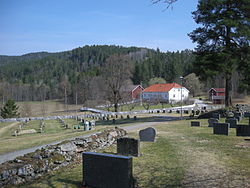Evje og Vegusdal
Evje og Vegusdal herred | |
|---|---|
 Evje Church cemetery and farm | |
 Aust-Agder within Norway | |
 Evje og Vegusdal within Aust-Agder | |
| Coordinates: 58°35′23″N 8°00′37″E / 58.5897°N 08.0104°ECoordinates: 58°35′23″N 8°00′37″E / 58.5897°N 08.0104°E | |
| Country | Norway |
| County | Aust-Agder |
| District | Setesdal |
| Established | 1 Jan 1838 |
| Disestablished | 1 Jan 1877 |
| Administrative centre | Evje |
| Area | |
| • Total | 510 km2 (200 sq mi) |
| *Area at municipal dissolution. | |
| Demonyms | Evdøl Veggdøl[1] |
| Time zone | UTC+01:00 (CET) |
| • Summer (DST) | UTC+02:00 (CEST) |
| ISO 3166 code | NO-0934 |
| Created as | Formannskapsdistrikt in 1838 |
| Succeeded by | Evje and Vegusdal in 1877 |
Evje og Vegusdal is a former municipality in the old Aust-Agder county in Norway. The 510-square-kilometre (200 sq mi)[2] existed from 1838 until its dissolution in 1877. It was located in the Setesdal region in parts of the present-day municipalities of Evje og Hornnes and Birkenes. The administrative centre was the village of Evje where the Evje Church is located.
History[]
The parish of Evje og Vegusdal was established as a municipality on 1 January 1838 (see formannskapsdistrikt law). According to the 1835 census the municipality had a population of 1,627.[3] On 1 January 1877, Evje og Vegusdal was divided to create two separate municipalities: Evje with a population of 870 and Vegusdal with a population of 935. These two municipalities later became parts of Evje og Hornnes and Birkenes respectively.[4]
Name[]
The municipality (originally the parish) of Evje og Vegusdal is named after the farms Evje and Vegusdal. The old Evje farm (Old Norse: Efja) is where the first Evje Church was built. The name is identical with the word efja which means "eddy", probably referring to the river Otra that runs past it.[5] The old Vegusdal farm (Old Norse: Veikolfsdalr) is derived from the old male name, Veikolfr meaning "weak Ullfr" and the second part is the word dalr which means "valley", hence the "valley of weak Ullfr".[6]
See also[]
References[]
- ^ "Navn på steder og personer: Innbyggjarnamn" (in Norwegian). Språkrådet.
- ^ Kiær, Anders Nicolai; Helland, Amund; Vibe, Johan; Strøm, Boye (1904). Norges land og folk: Nedenes amt (in Norwegian). Norway: H. Aschehoug & Company. p. 368. Retrieved 19 December 2020.
- ^ Registreringssentral for historiske data. "Hjemmehørende folkemengde Aust-Agder 1801-1960" (in Norwegian). University of Tromsø.
- ^ Jukvam, Dag (1999). "Historisk oversikt over endringer i kommune- og fylkesinndelingen" (PDF) (in Norwegian). Statistisk sentralbyrå.
- ^ Rygh, Oluf (1905). Norske gaardnavne: Nedenes amt (in Norwegian) (8 ed.). Kristiania, Norge: W. C. Fabritius & sønners bogtrikkeri. p. 193.
- ^ Rygh, Oluf (1905). Norske gaardnavne: Nedenes amt (in Norwegian) (8 ed.). Kristiania, Norge: W. C. Fabritius & sønners bogtrikkeri. p. 169.
External links[]
 Aust-Agder travel guide from Wikivoyage
Aust-Agder travel guide from Wikivoyage
- Former municipalities of Norway
- Evje og Hornnes
- Birkenes
- 1838 establishments in Norway
- 1877 disestablishments in Norway


